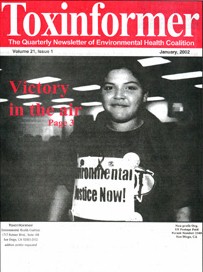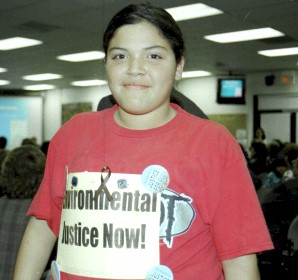|
|

| ||
|
|
|||
|
|
VOLUME 21, ISSUE 1, January, 2002 | ||
|
Communities victorious in ARB adoption
of new Environmental Justice guidelines After more than 18 months of development and debate, the California Air Resources Board adopted Environmental Justice policies to guide all of its programs at a hearing on Dec. 13, 2001. The adoption of the policies represented an acknowledgment by the Board that communities of color and low-income communities bear the brunt of air toxics emissions in the state of California. More than 200 residents from Southern California communities attended the hearing, which ended shortly before midnight on Dec. 13. Representatives from Environmental Health Coalition and the San Diego neighborhoods of Sherman Heights and Barrio Logan were on hand to testify to the environmental injustices that they face in their neighborhoods each day. The ARB’s decision represented a huge victory for residents of impacted communities and environmental justice advocates. The new policies, some of the most comprehensive ever adopted by a state agency, are the result of nearly two years of meetings between ARB officials, community residents, environmental and environmental justice organizations, industries, and representatives of the state’s local air pollution control districts. EHC worked closely with the American Lung Association of California, Communities for a Better Environment, the Coalition for Clean Air, and the California League of Conservation Voters Education Fund in advocating for the adoption of the policies. Forty-three environmental and community organizations endorsed a coalition letter in support of the guidelines.
The policies follow laws adopted in California that define environmental justice as, "the fair treatment of people of all races, cultures, and incomes with respect to the development, adoption, implementation and enforcement of environmental laws, regulations, and policies." These laws respond to growing community concerns about the potential health effects of exposure to multiple pollutants and toxic compounds. EHC and other community groups have repeatedly called for better protection from diesel truck and bus emissions and the pollutants from factories, refineries, power plants and landfills, often sited in or near low-income communities. EHC has worked on the local level to improve programs of the San Diego County Air Pollution Control District (APCD) in the County’s impacted neighborhoods, but historically has met with resistance from local officials and industry representatives. No representatives from APCD attended the December meeting. "The problem we have faced has been the regulation of toxics on a pollutant-by-pollutant, industry-by-industry approach," said Paula Forbis, co-director of EHC’s Toxic-Free Neighborhoods Campaign. "For the first time, these policies attempt to address cumulative impacts from multiple sources." Contrasting styles During the proceedings, ARB officials extended tremendous respect and consideration to the audience members. The Board provided Spanish translators for non-English speaking audience members and allowed community members with children to testify first. The meeting was a stark contrast to the Feb. 14, 2001 meeting of the San Diego County APCD meeting reported in the April 2001 edition of the Toxinformer. During this meeting, presided over by County Supervisor Bill Horn, a uniformed deputy demanded that more than eight Latina community members leave the meeting room because he claimed they were not seated or because they or their children were laughing or talking. Meanwhile, four white, male audience members continued to laugh and talk, and four white men remained standing in the aisles while the deputy removed the women and children. The deputy also removed and a translator hired by EHC for non-English speaking residents and relocated her to an adjoining room, because Horn said he thought she was speaking on a cell phone during the meeting. However, several minutes prior to the removal of the translator, Forbis had spoken with the County Clerk, showed her the translation equipment, and explained that the translator’s headset was not a cell phone. The ARB’s seven-point document establishes the framework for improving air quality and public health in all California communities. The policies will help advance this goal by making environmental justice considerations a standard practice in ARB activities. In all of its programs, the ARB promises to keep an environmental justice perspective when setting priorities and assessing the impacts of ARB programs and regulations. "These policies reflect the ARB’s commitment to improve air quality for all Californians, including residents of low-income and minority communities," said Dr. Alan Lloyd, ARB Chairman. "We intend to see that these policies are second nature to every effort of the ARB with tangible actions, not just words."
The document acknowledges the need for
added research into the potential health effects of exposure to a variety
of emissions from sources that include factories, power plants, refineries
and small businesses, such as gasoline service stations and dry cleaners,
as well as motor vehicles. It also acknowledges the need for further
research into the health effects of exposure to a variety of air toxics
simultaneously and into the improvement of air monitoring and computer
modeling techniques. • redirect existing resources to form a permanent EJ workforce within the ARB; • develop complaint resolution guidance by December, 2002; • develop land use guidance by early 2003; • develop cumulative impacts guidance by December, 2003; • form a working group to focus on how ARB could do more to incorporate pollution prevention; and • report every six months on the progress of EJ activities. "The ARB’s decision is a positive
first step," Forbis said. "Now we need to focus on ensuring
implementation of these policies." | |||

